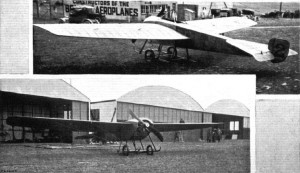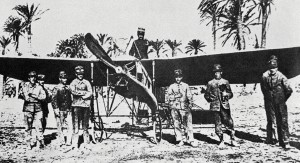Published on October 22, 2012
“Geoffrey,” Charles Davenport began, “you don’t think much of this new practice of aviation, do you?”
Geoffrey stopped for a moment from his business setting out tea in the library. “No sir, if you value my opinion enough to ask me, then I will say these flying machines are death-traps. Why another person would think it wise to play about with them is beyond me. What good can come of it?”
Charles nodded his head and thought about that, then added, “Yes, a good question — what good can come of it?” He turned to the week’s issue of Flight, flipping past the diagrams of the latest airfoils, editorials and latest aeroplane designs — pausing only for a moment to look at the photo of Claude Grahame-White in a Farman rounding the No. 2 pylon at Hendon. Wonderful, he thought — and yes, here it is, the international news….

The first story was quite troubling, it seemed that all of the Continent was in pursuit of aeroplanes for military use, and it was just Britain that was seemingly stalled in its desire to make good use of flying machines in reconnaissance. Now, the French had set high mark….
Aeroplanes for French Army.
So far the French National Fund has produced practically £70,000, which with the £300,000 voted by the Chambre for the purpose of buying 300 aeroplanes, makes a total of £370,000 which the French have for spending on aeroplanes this year. The greater part of the 300 machines has already been delivered and they will all be handed over before the end of the year, by which time the army will also have 62 additional machines purchased by the National Fund.With regard to the ordering of the aeroplanes a new system been commenced, a commission, consisting of the chiefs of the Aeronautic Centres, Cols. Bouttieaux, Etienne, and Breton, have been appointed, and it will meet every six months, and draw up a list of machines to be ordered, and arrange for their delivery. Another commission has been appointed which will the duty of supervising the deliveries of the machines.
As well, the second story instantly caught his eye.
A Record Overseas Trip.
An Italian aviator, Nino Cagliani, sprang into fame on October 9th, through his splendid flight from Pisa to Bastia, Corsica. He left Pisa at 3.27 p.m., and landed safly at Bastia at 5.30, taking two hours for the voyage of 150 kiloms. His machine was an Antoni monoplane, built in Italy, on Blériot lines, and fitted with a Gnome motor.
Even the Italians, he considered — and then there was an ominous story that he read four times and considered against the other news of the day, from the Daily Mail, that the Italians had just finished their battles against the Ottoman Turks in Libya. If indeed there was to be a fight, then the value of the aeroplane as a reconnaissance instrument of war had already been proven over this last year! The Italians had even shown the world that bombs could be dropped from aeroplanes! Even that had not awakened the British Government from its self-induced slumber.
Recent Deliveries of Farmans.
Apart from recent deliveries to the French Government, the Farman firm have within the past few days despatched machines to Italy, for service in Tripoli, while others have been sent to Greece and to Japan.

Finally, Davenport read a series of stories about the rise of French aviation.
Legagneux Flies at Night.
Late in the afternoon of the 9th inst., Legagneux, on his Blériot-Gnome machine, started from Compiegne, and landed at Chartres after dark.Long Flights at Farman School.
Among the many fine performances at the Farman school at Buc last Saturday may be specially mentioned a trip of 2 hours by Liut. Vanduyck, who has just finished his period of tuition, one of 40 mins. by Adjutant Panent, and the fine flying of Lieuts. Godob and d’Abrantes over Trappes, St. Cyr, Versailles, &c.Guillaux a Superior Pilot.
On his Clement-Bayard metallique monoplane, Guillaux on Sunday completed two tests for his military brevet, flying from Issy-les-Moulineaux to Montoire-sur-Loir, covering the 390 kiloms, in 3 hours 5 mins.More Excursions by Vidart.
On Sunday, Vidart, on his Deperdussin-Gnome machine, made an excursion over Port d’Ain and Bourg-en-Bresse. On his return to Amberieu he was flying for some time over the town and also round the Bugey mountains.Madame Archdeacon in the Air.
Among the visitors to the Buc Aerodrome on the 11th inst. who were give them bapteme de l’air by Mr. Maurice Farman were Madame Archdeacon and Madame Delaunay.
Davenport set the copy of Flight down. This military build-up was quite troubling indeed. And now even the French ladies were flying the new Farmans! Certainly they were good machines, in fact, Claude Grahame-White swore by them as well, but that wasn’t the point. The Great Game, no matter what the Ministers in the Parliament might proclaim, was indeed on and in earnest.

One More Bit of Aviation History
On this date in aviation history in Libya, in 1911, the Italians had brought in their entire fleet of aeroplanes to Tripoli to use against the Ottoman Turks — two Blériot XI machines, three Nieuports, two Farmans and two Etrich Taube aeroplanes with their dove-like wings. As the day drew on, upon October 22, 1911 (some sources say that the date was October 23), the Italian Army flew its very first reconnaissance flight with a Blériot XI in the hands of Captain Carlo Piazza. Capt. Piazza took off from Tripoli and flew to Azizia. As he flew, he logged the positions of the Turkish infantry and oasis camps, information that would greatly aid the officers as they planned what would be a year long military campaign. Many call the flight on this date in history the world’s first combat reconnaissance mission, setting into a motion a dark history of wartime uses of aircraft that few could have foreseen.
Today’s Aviation Trivia Question
Who was Madame Delaunay-Belleville?

The unusual appearing aircraft is a Bell Airacuda, a reconnaissance plane built
in 1937 for the United States Army Air Corps, which rejected the plane in favor of the XP-39,
also built by Bell Aircraft Company.